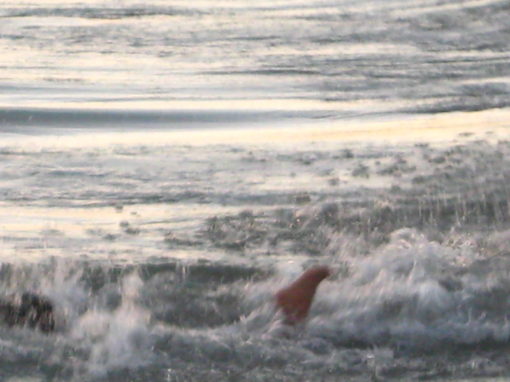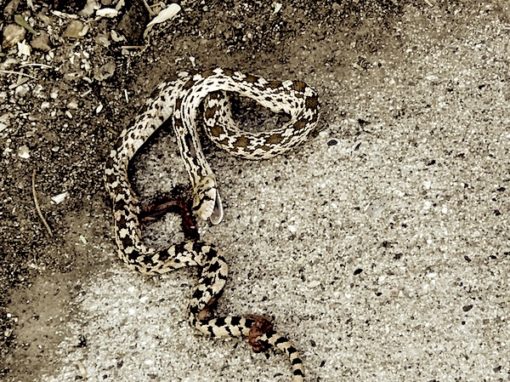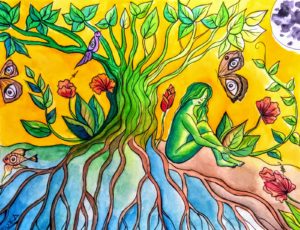A fire can burn a hole in the ground in the shape of a root, of a twisted, gnarled thing that once was the source of life for a tree. The root was a water source–a sorcerer of sorts–who for all its ability to hold this life-giving liquid couldn’t save itself, nor the thing it cared for. The root hole lies on the ground, an ashy shadow, like the bodies of the people buried at Pompeii that were curled into an eternal, hellish freeze. As if the root, like the people, evaporated into thin air, the outline of its shape the only proof it was ever there.
I saw an image of this root-shaped depression today while at the Fingerprinter’s Office. The Fingerprinter, the title I have given to the man who takes my prints, is young, perhaps only a few years older than my twenty-nine years, and he has a head full of exploratory curls. They are mostly red, these tendrils, but they’re turning white and gray at their roots. He is taking my unique fingerprints for my summer job. Fingerprints seem so permanent, immutable, unless, of course, they are cut or burned. They are one of the only ways we are identified in this mass of a world.
In Ecuador, where I used to live, they used ink rather than fancy screens to take my prints. The process would stain my fingers black and purple for days. I think about this, how much has changed in two years, as I start chatting with the man about the beauty of San Rafael, and of Fairfax, CA, a quiet, cozy town next door. He smiles and shakes his head, “There’s nothing that’s really happening there,” he says. Mendocino, that’s where stuff is happening, I soon learn. And Santa Rosa, he says, where he lives. “Where the fires happened,” I add. He nods. That’s all they seem to be known for these days.
The Tubbs Fire, as it’s now known, burned in October 2017. It swallowed up entire neighborhoods in Santa Rosa, I had heard, and I’d seen the blackened lots last May, the remnants of what is left. The Fingerprinter begins to tell me a bit about that time. “Over 40 people died,” he said–44, I confirmed, “And over 20,000 people were displaced.” The town itself has about 100,000. Imagine 1 in every 5 people you known, in your town, suddenly without a home.
Though hesitant, he also feels eager to me, ready to tell a stranger, an outsider, about the experience of the fires, of his community. “We don’t really know how outsiders see it,” he’ll tell me later. He wasn’t in the fire himself. Early that morning, 2 AM on October 9, he was in Petaluma, about 15 miles away from Santa Rosa. He woke up suffocating on the smoke, smoke so thick it came through closed windows and gutted the house he was in. 15 miles away, Santa Rosa was enveloped in near instantaneous flames.
“Nobody had time to take anything,” he said. They didn’t know it was coming. A friend of his in town had to run into his neighbor’s house. Half the house was already on fire, and the neighbors were inside, sleeping. Nobody was prepared.
Afterward, he says, that’s when it all sank in. People didn’t know what to do. It was a lot of waiting, watching, helping on the humanitarian side of things. During the fire, no one could go in there with a hose or anything, he clarifies to one of my questions. Even the firefighters couldn’t stop it. After, people set up shelters in houses if they could, and helped out. “We’d all drive to surrounding towns and buy up water supplies all throughout here…” he gestures outside to the surrounding San Rafael– “They all ran out of water bottles pretty quick.” But people weren’t the only ones affected as the dust was settling. “You don’t often think about the animals that were there.”
It wasn’t just the people living there who were affected. Dogs, cats, other domestic animals. Horses. When the houses burned, all of these animals were out on the streets, too. Chubby Garfields and tiny Chihuahuas, animals who had only ever seen the inside of a house or the outer world from the end of a leash, were unexpectedly thrown into “freedom” in the middle of burning timber and lashing flames. Separated from their families, these animals would have run, blind and choking, trying to survive. I imagine the horses sensing the fire before the humans, neighing in their stables at midnight or 1am, and the dogs growling low, and the cats scratching at the door. They must have known, in some way, what was coming, and for those that survived, they too were left terrified.
Afterwards, he tells me, people would drive around and round up all the strays, taking them to shelters full of pets, helping families reunite with their animals, bringing some small sense of relief in the middle of chaos.
In the year and a half since, Santa Rosa has been rebuilding, but it’ll take years. Growth is slow. “And what about what was lost in the fires,” I ask. “Is the government helping?” He shrugs his shoulders. What can you do when you’ve lost everything? Santa Rosa wasn’t the only one though, he’s quick to add. “Have you heard of Paradise?” I shake my head. Paradise, CA is a small town, mostly rural, up by Chico. It’s 160 miles north of Santa Rosa, north of Sacramento. The fire burned it up completely.
“You think Santa Rosa is bad,” he says, “There’s nothing left in Paradise.”
Nobody really talks about it as much, he explains, because it was a lot of land, livestock, agriculture. Now, there’s nothing left there. The Camp Fire, which started as a brush fire on November 8, 2018, took 86 lives and over 90% of the houses of Paradise. It was a town where the fire acted as it never had before, and people had to flee, driving through walls of flames in their desperate attempts to survive. Paradise, though, is not the only other place he wants me to know.
“Have you heard of Oroville?” he asks me next. I shake my head, thinking it was Orville like the popcorn. An Arizonan, I know very little about this part of California, though I’m piecing it together while he explains. The Fingerprinter shows me Orvoille, CA, a town by Oroville Lake where he used to play as a kid at his friend’s house. He went up there a few months ago with his friend to see the damage. They hadn’t been able to go back for weeks and weeks after the fire had burned while everything was being controlled and cleared. The friend’s house is the only one left standing in that area.
He shows me photos and videos from that trip. The house next door is reduced to a black rectangular mark on the earth. It’s in these photos that I saw the photos of the trees, twisted and gutted, hole-y and halved. To a quick-glancing eye, the scene might almost appear autumnal. Everything is red and a little golden, different hues of brown. “This was all green,” he tells me. “Green, green, green, these forests where I ran around as a kid. And now?” Silently, we both imagine forward, the young kids being born and growing up in this area.
What will the word forest mean to a kid growing up in Northern California five years from now? What images will come to mind?
Amongst the dozen photos, there’s one of a large tree being strangled by a fallen electrical line. The wire chokes the branches a few feet off the earth. “There isn’t…electricity…still running through there?” I ask with bafflement. “No, they shut it off, but that’s what started all this in the first place,” he offers, looking at me directly, as if he’s finally gauging his audience, weighing whether or not to tell me what he really wants to share. I encourage him to tell me more.
He tells me how the Tubbs Fire had ignition points along electrical lines. The power lines are what started this catastrophe. Add unkempt house yards and overgrown national forests and 60mph winds that can breathe a spark to life, and you have devastation. “This was man-made,” he reiterates. The result of neglect.
Because in a storm, he explains, in 60mph winds, there’s someone with the utility company who’s supposed to turn off the lines to make sure they don’t spark, and that didn’t happen.
“So are they being held accountable?” I ask, praying the answer is yes. Outdoor etiquette 101: if you start a fire from your campsite, or while you’re out hiking, and it spreads, you are held liable. Every hiker, walker, Scout, knows this, and fears it with good reason. It’s your responsibility to protect nature as you explore. I imagined the same must be true for this large company, but he only shakes his head. Apparently this simple cause and effect logic doesn’t apply to giant conglomerates, in particular to the monopoly that is PG&E in California.
PG&E is the only power company in operation around here, and sure, he adds, that guy who didn’t do his job by turning off the power probably got let go after he gave up some apology, but the problem isn’t just with him. It’s with the overgrown, uncared for trees around the lines. It’s with the company thinking it can get away with anything. It’s with the fact that no one even has a choice, he tells me. In a competitive, capitalistic market, we are, of course, empowered by our choice. Nowadays, it sometimes feels like our money is one of the best ways we can be activists, by choosing what we buy, from whom and how often. In California, PG&E has no competition. “Even if you’re on full solar power, you still have to pay into the local grid.”
And now, he adds, angry folks who lost a lot are shooting at the guys out there in PG&E trucks who are trying to get the electrical lines back up and working. “It’s not their fault,” he says, shaking his head. “They’re just the frontmen out there, guys doing their jobs, but the real guys with the power are in the offices.” I go back to liability, because I cannot believe there is no accountability at all. What about lawsuits? Oh sure, he confirms, there are plenty out there, with powerful lawyers fighting for the people, but he doubts there will be a grand reckoning. PG&E is too powerful.
He shakes his head in a helpless, though not hopeless, way. What can one person do?
This question, what can one individual do, has been coming up a lot in my life lately. We sit with the silence of the responsibility. Weakly, though honestly, I reply, “Tell someone else.” And then, “Maybe support the lawyers who are fighting the legal fights, and keep helping those around you, and stand up to PG&E in some way…” I trail off. We both pause, again, at how insignificant these actions actually feel in the overall weight of the fight–a fight against corporations and capitalism and, perhaps more than anything, an epidemic of apathy that has invited people to not care for the world around them and for others in it…
a concocted world where people have become consumers more than creators, where minds have become industrial products more than innovative prophets, and where success has become measured in formulaic calculation more than radical compassion.
“Here in California,” he tells me, while holding that eye contact, not mincing a single word, “we’re used to fires.” I hear how they are. They’re used to the burning of a town, a place, a people, an idea. It can feel insurmountable, these battles that we as humans, here as Americans, have created for ourselves. The apathetic part of the mind may say it’s all too much, while the angry part of the mind screams from rooftops. The soul may want to detach and run away and hide, or it may want to step forward and talk and write and fight. We all must come to terms, however we can, with the battles around us as the dust and smoke settle and the truths become more clear. We are left looking at the ruin of a town, of a city, of a national park, of a life. But it’s not yet lost.
There, hidden in the ash, are buds of possibility. The botanists say the forests are regrowing here, the hills are once again colorful with wildflowers.
And yet, they’re quick to caution, don’t you dare let the pretty colors fool you. This work will not be done for us.
Most of the species coming in are non-native species, and they are more often than not invasive, like the spiky pink thorns of milk thistle. Native species, like manzanita and sage, need more time to grow, usually 2-5 years. They, the natives, are the ones that need help. Hence why some groups are going out and removing the invasive growth in an attempt to bring back what was. It’s a valiant effort, and begs the rhetorical question, can such a return happen at this stage?
I’m reminded of a wise woman I know, a woman who has suffered many of her own battles. She once told me every problem comes with a gift. She told me this while she was talking about her child close to death. But she holds this truth to be one of the most undeniable.
“The bigger the problem,” she’d tell me, “The bigger the gift.”
The burning of Paradise, of Santa Rosa, of Oroville, of the dozens of other cities and parks in Northern California, is a huge problem. The power of PG&E, a large corporation that may not be held accountable fully for its role in this destruction is a huge problem. What type of gift could equal this scope of tragedy?
As I’ve meditated on this all afternoon, the only thought I can come up with is the gift of consciousness. Awareness, truth. Waking up to reality is a gift. It is a gift to have your eyes opened by Fingerprinter who takes time to share some of his truths. It is a gift to listen to another’s story, to understand better the power dynamics at play, and to pass on what you’ve heard. What can one person do, he had asked me. It is a question that cannot be asked too much, or we may, I fear, become lost in the asking of it rather than the answering. He tells me to tell others, to encourage folks to tend to their yards, to ask the national parks to clear out trails more, to better tend to native species. We start small, we start here.




